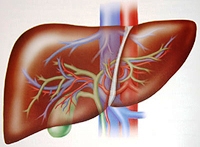Most of the population (85%) of Russia know nothing or has a minimum idea of viral hepatitis and only 21% of the respondents call it as the main reason for the development of liver cancer - these are depressing survey results.
Content
 Public opinion poll held in September-October 2013 on the initiative of the company Jansen Pharmaceutical NV (Janssen) with the support of the International Hepatitis Alliance (WORLD HEPATITIS ALLIANCE, WHA), European Liver Patients Association, ELPA (European Liver and the International Liver Cancer Association, ILCA International Association (International Liver Cancer Associationone , covered more than 1000 Russians older than 18 years. Studies have shown the insufficient awareness of society about hepatitis and its consequences, in particular on the risk of liver cancer — the sixth prevalence of the oncological disease and the third cause of death around the world2.
Public opinion poll held in September-October 2013 on the initiative of the company Jansen Pharmaceutical NV (Janssen) with the support of the International Hepatitis Alliance (WORLD HEPATITIS ALLIANCE, WHA), European Liver Patients Association, ELPA (European Liver and the International Liver Cancer Association, ILCA International Association (International Liver Cancer Associationone , covered more than 1000 Russians older than 18 years. Studies have shown the insufficient awareness of society about hepatitis and its consequences, in particular on the risk of liver cancer — the sixth prevalence of the oncological disease and the third cause of death around the world2.
The results of the survey indicate a depressing public awareness of these dangerous diseases. Only every 7th person is well aware of viral hepatitis and ways of infection, the overwhelming majority of respondents have a minimum representation of them (72%), or do not know anything (13%). Hepatitis — This is a viral inflammatory disease of the liver, provoking a short-term or acute infection. Hepatitis B, C and D viruses can lead to the development of chronic hepatitis — long-term infectious disease, threatening serious complications, such as cirrhosis (liver scarring), liver failure and liver cancer. Currently, up to 90% of persons infected with hepatitis B viruses and hepatitis C do not know what sick3.
Despite the high mortality from liver cancer, only 21% of people know that the main cause of oncological lesions of the liver cells is precisely viral hepatitis. According to the medical community, a total of more than 500 thousand cases of liver cancer (which is 90%) are associated with infection with hepatitis B and C viruses4.
Most (4 out of 5 people) are aware that viral hepatitis is transmitted with blood or other biological fluids of an infected person, but much less people are aware that hepatitis can be infected with sexual contact, in medical institutions when using non-sterile tools, in Tattoo Salon, When using common household items with infected and t.D. Nevertheless, in Russia, compared to European countries, only 4% of respondents do not know that hepatitis B and C are transmitted precisely from a person to a person.
The general awareness of the population about the availability of methods for the prevention and treatment of viral hepatitis is insufficient — According to a survey, people are often mistaken in their judgments about the symptoms and capabilities of the treatment of viral hepatitis B and C. So, every fourth respondent knows whether physically symptoms of hepatitis are manifested. And only half of citizens are informed about the possibilities of prevention and preventing this disease. In the case of hepatitis with the situation even worse — Each second believes that symptoms in this case will definitely be visible in this case, and 4 of 10 respondents also believe that the prevention of this disease exists. At the same time, if every second Russian knows the possibility of vaccination in the case of hepatitis B, then only every third is informed about the absence of vaccination against hepatitis with.
According to the survey results:
- 31% of respondents do not know whether there is a vaccine against hepatitis B, and 20% are mistaken in that there is no such vaccine;
- 15% of the population believe that there is no treatment from hepatitis;
- 36% are mistaken in the existence of vaccination against hepatitis C and only 31% are confident that there is no vaccine from this virus;
- 20% of respondents believes that today there are no available methods for the treatment of hepatitis C, another 23% know nothing about it;
- 44% of respondents do not know that hepatitis C — This is a curable disease.
The level of awareness of Russians on viral hepatitis is extremely low and cause serious concern for doctors and representatives of public organizations.
«Given the direct dependence of the development of liver cancer from infection with the hepatitis virus, it is necessary to make efforts to combat this disease, — said the chief gastroenterologist of the Health Department g. Moscow, head of the department of hepatology TsNIIG, Professor d.M.N. AND.G. Bakulin. «First of all, the attention of the state to this problem. Priority Tasks: Creating a patient register, improving the level of diagnosis, the introduction into the practice of modern methods of treatment, which make it possible to significantly increase the amount of cured patients, regular monitoring of the quality and timeliness of patient treatment. All these measures will allow in the near future to cure chronic hepatitis with as a disease and save lives to many people».
«The problem of the widespread spread of viral hepatitis concerns not a separate person, but the whole society. It is necessary to carry out the prevention of the spread of hepatitis through widespread public informing about the risk factors and treatment methods. We believe that in our country, measures of state support of citizens infected with viral hepatitis should be implemented,.To. The law recognizes these diseases socially significant», — Comments the co-chairman of the All-Russian Union of patient associations, President of the All-Russian Society of Hemophilia.BUT. Jew.
If you think that you or some of your loved ones can be at risk of infection with viral hepatitis, it is important to discuss it with a doctor!
reference Information
On the study
The results were obtained during the online survey conducted by EDELMAN BERLAND (in partnership with ICM company), in the period of September 20—October 15, 2013. The survey passed more than 5,000 persons who are not related to medicine, aged 18 and older in four countries: Great Britain, Spain, Russia and Turkey. The purpose of this study — Identify the degree of awareness and perception of hepatitis B and hepatitis C and their connection with liver cancer by society.
On the month of awareness of liver cancer
Liver Cancer Awareness (Liver Cancer Awareness Month, LCAM) — This annual health campaign (is held in October), organized by the liver cancer, patient groups and other specializing in this disease by organizations. The campaign is aimed at raising awareness of diseases that contribute to the development of liver cancer and existing preventive measures, as well as to attract financial resources for further research on its causes, prevention, diagnosis, treatment and recovery.
About Hepatitis C
Hepatitis C — It is an infectious disease of the liver, which is transmitted through contact with blood or other biological fluids of an infected person and at the initial stage usually proceeds asymptomatic6. Since the world has about 150 million people infected with this virus6, And every year, 3-4 million are infected for the first time, hepatitis C is a heavy burden for patients and society12. According to estimates, the disease leads to death more than 499 thousand people around the world every year, which is approximately 1% of deaths10. This is the main world cause of the liver cirrhosis and cancer13, Moreover, cirrhosis develops approximately 20-30% of patientsfourteen, In 7% of which liver cancer in the futureeleven. According to estimates, the annual costs associated with hepatitis C (treatment and health loss), only in the United States account for more than 1 billion dollarsfifteen.
About the European Association of Patients with Liver Diseases
The European Liver Patients Association, ELPA (EUROPEAN LIVER PATIENTS ASSOCIATION, ELPA) emerged from the desire of groups of patients with liver diseases in Europe Share approaches used in various countries. In June 2004, groups of patients out of 10 European and Mediterranean countries met to create an association. Formally, ELPA was organized in Paris on April 14, 2005 during the Annual Conference of the European Liver Study Association (European Association For the Study of The Liver, EASL) and now includes 30 members from 24 countries. The purpose of ELPA is to promote the interests of people with liver diseases, in particular, the coverage of the problem, assistance in raising awareness and in prevention, solving the problem of insignificant attention to liver diseases compared to other areas of medicine, such as heart disease, exchange of successful endeavors, work with professional organizations such as EASL, to ensure the harmonization of treatment and care methods in Europe and achieving the highest standards.
About the International Association for Liver Cancer
International Liver Cancer Association (ILCA International Liver Cancer Association, ILCA) — This is the only international association, which is exclusively studying liver cancer for specialists in all related disciplines. ILCA is committed to improving the studies of pathogenesis, prevention and treatment of liver cancer by promoting innovative pathogenetic, diagnostic and therapeutic interventions about liver cancer, for which it uses a transverse approach to research and combines scientists, doctors and specialists from close adjacent regions.
About the International Alliance to Combat Hepatitis
International Hepatitis Anti-Hepatitis Alliance (WORLD HEPATITIS ALLIANCE, WHA) — This is a non-profit non-governmental organization (NGO). It includes more than 170 organizations working in the field of viral hepatitis and representing all regions of the world. WHA manages patients, and the organization itself is aimed at the needs of the patient community. Thanks to the commitment to this approach, only patient organizations have the right to vote in this alliance. Internationally WHA expresses the opinion of 500 million people worldwide living with viral hepatitis. Ultimately, the goal of WHA is working with the governments of countries by raising awareness, improve prevention, care, support and increasing the availability of treatment to eliminate these diseases on the planet. In different countries of the world, WHA conducts guidelines and supporting activities, allowing to reduce the number of victims from viral hepatitis and improve the life of patients.
Bibliography
- Ferlay J, Shin HR, BRAY F, FORMAN D ET AL. Globocan 2008 v1.2, Cancer Incidence and Mortality Worldwide: IARC CANCERBASE NO. 10 [Internet] Lyon, France: International Agency for Research On Cancer, 2010. Available on the website: http: // globocan.Iarc.Fr.
- Parkin, Dm. THE GLOBAL HEALTH BURDEN OF INFECTION-ASSOCIATED CANCERS IN THE YEAR 2002. Int j Cancer. 2006; 18 (12): 3030-44.
- World Hepatitis Alliance. Abou vial hepatitis. Available Online: http: // www.worldhepatitisalliance.ORG / EN / ABOUT-VIRAL-HEPATITIS.HTML.
- ELPA. Liver Cancer Prevention: Getting Viral Hepatitis Under Control. EUROPEAN WEEK AGAINST CANCER 2013. May 29, 2013. Available on the site http: // www.Easl.EU / ASSETS / Application / Files / 785D69FeecFB1BA_File.PDF.
- World Health Organization. Media Center: Hepatitis B. July 2013. Available Online: http: // www.who.Int / MediaCentre / Factsheets / FS204 / EN /.
- World Health Organization. Media Center: Hepatitis C. July 2013. Available Online: http: // www.who.int / mediacentre / facstsheets / fs164 / en /.
- Health Consumer Powerhouse. Euro Hepatitis Index 2012 Report. Available on the site http: // www.HEP-INDEX.EU / TL_FILES / HEP-INDEX / DOWNLOAD / REPORT_HEPL_HCP_121103.PDF.
- Economist Intelligence Unit. The Silent Pandemic: Tackling Hepatitis C WITH POLICY INNOVATION. January 2013.
- CDC. Hepatitis B. Available Online: http: // www.CDC.GOV / HEPATITIS / HBV / HBVFAQ.HTM # Overview.
- Global Burden of Disese Study 2010. The Lancet. 2012. Available Online: http: // www.Thelancet.COM / Themed / Global-Burden-of-Disease.
- Blachier M, Leleu H, Peck-Radosavljevic M, et al. The Burden of Liver Disease in Europe: A Review Of Available Epidemiological Data. European Association for the Study of the Liver 2013.
- World Health Organization. State of the Art of Vaccine Research and Development. Viral Cancers. Available Online: http: // www.who.Int / Vaccine_Research / Documents / Viral_cancers.PDF. Last access in October 2013.
- Rosen Hr. Clinical Practice. Chronic Hepatitis C INFECTION. N Engl J Med. 2011; 364 (25): 2429-38.
- HEP C TRUST: Overview of Stages. Available Online: http: // www.HepCtrust.Org.UK / HEPATITIS_C_INFO / STAGES + OF + HEPATITIS + C / OVERVIEW + OF + THE + STAGES. Latest access in October 2013.
- El Khouury A, Klimack W, Wallace C, et al. Economic Burden of Hepatitis C-Associated Diseases In The United States. J Viral Hep. 2012; 19: 153-160.









